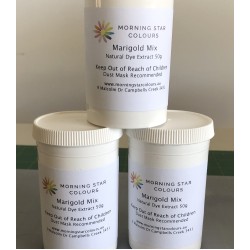Our pure extracts of plant dyes are easy to use and can result in a beautiful range of colours.
Instructions included with any dye purchase.
Model: powdered-dye-cochineal
Cochineal is a scale insect that feeds on a cactus in arid areas of mid and South America. lt is one of the most concentrated dyes, and will dye pink through to raspberry.
Adding cream of tartar shifts the colour to a lovely warm pink. Use distilled water for dyeing if you live in a hard water area..
$23.00
Ex Tax:$20.91
Model: powdered-dye-cutch
Cutch (Acacia catechu) is common in India and Burma, and is the rich reddish brown color seen in Indian textiles. It will give good results on all fibres.
For the deepest shades mix the Cutch with water and let sit overnight. Simmer your fibre for 2 hours. Adding Soda Ash at 1 % WOF will redden a..
$11.00
Ex Tax:$10.00
Model: dye-fustic
On cottons this will dye gold, and on silk and protein fibres will give colours from gold to orange.
For light shades use 1 - 2 % WOF, medium shades use 3 - 4 % WOF and darker shades use 5 - 10 % WOF...
$15.00
Ex Tax:$13.64
Model: powdered-dye-himalayan-rhubarb
Himalayan Rhubarb will yield a deep golden yellow with an alum mordant. Make sure to stir well to fully dissolve the powder.For light shades us 1 - 2 % WOF, medium shades use 3 - 6 % WOF and darker shades use 7 - 10 % WOF...
$18.00
Ex Tax:$16.36
Model: powdered-dye-lac
Lac extract requires an extra step in order to develop the rich colour. Instructions included with your purchase.Dyes pink, crimson and burgundy. It is an affordable alternative to Cochineal.Use 3 % WOF citric acid and dissolve this in the dyebath with the Lac extract. Strain before using to remove ..
$22.00
Ex Tax:$20.00
Model: powdered-dye-madder
Madder is one of the oldest traditional dyes giving a range of reds and corals. Madder can be used with alum to obtain brick reds and rusty oranges, or with cochineal to obtain a true red.
Calcium Carbonate at 1 % WOF will bring out the deep red colour of Madder.For light shades use 0.5 - 2 % WOF, ..
$25.00
Ex Tax:$22.73
Model: powdered-dye-marigoldmix
Our new marigold mix!1 - 2% WOF for a light colour5 - 6 % WOF for a medium shade 8 - 10 % WOF for darker shadesMix with our Saxon Blue for greens...
$25.00
Ex Tax:$22.73
Model: powdered-dye-pomegranate
Pomegranate is used in India as both a dye and tannin rich mordant. It produces a matte green-yellow colour.It can be combined with Logwood to produce a dark olive green or if over dyed with Indigo it will produce a rich blue green. Use 1 - 3 % WOF for light shades, 4 - 6 % WOF for medium and 7 - 10..
$8.50
Ex Tax:$7.73
Model: powdered-dye-logwood
Logwood yields a rich, deep purple, but by itself is not particularly lightfast, so keep from bright sunlight. With added iron, its lightfastness increases and the color darkens.
This grade yields a brighter, deeper and richer purple shade.For light shades use 1 % WOF, medium 2 % WOF and darker sha..
$30.00
Ex Tax:$27.27
Model: powdered-dye-walnut
This dye is extracted from walnut hulls and gives a rich brown. A mordant is not needed, but alum can be used to alter the colour. To develop the colour, the extract needs to be simmered for 2 hours and left overnight before adding the fibre.
For a light shade use 5 - 10 % WOF, medium use 11 - 50 %..
$13.00
Ex Tax:$11.82
Model: powdered-dye-weld
Weld is the most lightfast of the yellow dyes, and the brightest and clearest yellow flower dye with a distinct green caste. Lime green can be obtained in combination with indigo.
Use 0.25 - 0.75 % WOF for light shades, 1 - 2 % WOF for medium and 3 % WOF for a darker shade.Adding Calcium Carbonate ..
$30.00
Ex Tax:$27.27
Showing 1 to 11 of 11 (1 Pages)


